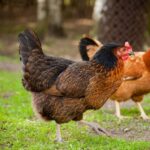You can eat the comb of a chicken if you want to do so, yes. In fact, in some parts of the world, it’s somewhat of a delicacy. It’s not to everyone’s taste though, it has a “gelatinous texture” and not a lot of flavor. It’s more a case of stomaching it mentally for most people.
Table of Contents
Do People Really Eat Chickens' Combs?
There is actually some interesting history attached to eating chicken combs. More specifically, combs from roosters which are referred to as cockscombs.
Historically, roosters’ combs were seen as symbols of masculine prowess when eaten. As was a lot of offal meats, such as kidneys and other organs in centuries passed.
I know I’ve heard the eating of cockscombs talked about in Roman banquets and as part of French cuisine. As well as being used as a staple in peasant cooking due to being a cheap way to recycle edible parts of roosters that may have otherwise been discarded.
Fast forward to the modern-day, and you can still find dishes, cultures, and places where chickens’ combs are being eaten.
It’s popular across Asia, where they are known to not waste edible parts of animals. As well as being commonly used to make sauces in France and Italy.
There is certainly a demand for combs, and there are some chicken farms that will save and sell on the combs when preparing birds for sale. Although doing a quick search online, it’s not easy to find combs if you were hoping to pick some up to try yourself.
Eating combs isn’t common in the western world. Although, it’s usually our view of certain foods and animals that stop us from eating certain things.
I’m pretty sure if I invited friends over and served up some combs they wouldn’t touch them. Yet, they’ve probably eaten them in sauces and would try it if I didn’t tell them what it was and they had no idea.
Strange, right?!
What Is a Chicken Comb Made Of?
The comb is a complex and interesting piece of chicken anatomy. It’s just a ‘red thing’ on the head of a chicken to most people, but there’s a lot more to this organ that you’re probably aware of.
There are several layers to a comb, and it’s made up of a number of collagen fibers which gives it a squishy, elastic consistency.
If you’ve ever felt a comb, it’s pretty durable and spongy. Not that you should be squeezing it when it’s still attached to a chicken, that can be painful for the chicken.
The comb also contains a network of veins, arteries, and blood vessels. There is blood flowing through this organ, as you’ll have noticed if you’ve ever seen a chicken that’s been victim to a bit of pecking from a flock mate.
According to eatthismuch.com, combs contain around 2% fat, 7% protein, and some decent nutritional content.
Related - Here's everything you need to know about dubbing (removing a chicken's comb).
What Does Chicken Comb Taste Like?
Chicken combs do not have a lot of flavor on their own. This is why they’re often used as a garnish, or served with other strong-flavored foods.
For example, I found an interesting recipe for cockscomb with cherries and vanilla rice pudding (sounds delicious, right?). As well as one for crispy fried cockscomb seasoned with lemon, salt, pepper, and garlic.
Texture-wise, I’ve seen comb described as being like eating tongue. If you haven’t tried tongue, then think about another slightly chewy meat like a piece of tough beef.
Why Are Cockscombs Not More Commonly Eaten?
I know what you’re thinking. I’ve explained that cockscombs are nutritious and used in some cuisines. Yet, they’re pretty hard to find in most countries.
With millions of chickens being butchered each week there must be a lot going to ‘waste’.
I think the main reason why combs are not more commonly available or used, especially in the western world, is due to how people think about them.
This doesn’t just apply to this organ, but offal meats in general.
A lot of people are put off knowing they’re eating something they’ve seen on an animal moving around - or know performs a certain function - like the liver or kidneys.
To take this one step further, a lot of people who raise backyard chickens could never imagine butchering and eating one of their chickens.
Yet, they will happily buy chicken from the supermarket to eat.
It really comes down to how you perceive the food in front of you. As humans, if we can associate what we’re eating with a living thing and haven’t been conditioned from a young age, it’s often hard to eat it.
I think combs fit this bill, especially as they’re often served to look just as they did when they were on a rooster’s head.
Related - Ever wondered if you can hatch supermarket eggs? (Me too, here's the answer)
What Is the Purpose of the Comb on a Chicken?
You’re probably wondering why chickens have combs, right?
Not many people know this, but the main purpose of this organ is to help a chicken regulate its temperature.
As warm blood flows through their comb (and wattle) on a hot day, a cool breeze helps cool it down a little as it re-enters their body.
They’re also used to attract potential mates. As with a lot of displays in the animal kingdom, the larger the comb, the more attractive hens typically appear to roosters.
Combs are also a good general indication of how healthy a chicken is. Pale, drooping, floppy or damaged combs are often one of the first signs that a chicken is unwell.
Who would have thought it. Combs aren’t just for decoration, they play a vital role in the health and wellbeing of a chicken!
Can You Also Eat Chickens' Wattles?
When it comes to eating wattles, which are the red fleshy things on the underside of a chicken’s head, it’s a different story.
I’ve never heard about anyone eating wattles, either centuries ago or in the modern-day.
This isn’t to say it doesn’t happen or you can’t eat wattles. To my knowledge, wattles are a very similar texture and composition of combs. So, I’m sure it wouldn’t do any harm.
I think it’s really down to the fact that they are typically much smaller than combs. It would take a lot of wattles to serve up anything of substance, meaning it’s going to be expensive.
In Summary
Now you know - people do eat chicken combs. In some cultures, they literally serve them up on plates looking like they haven’t long been removed from a chicken’s head.
These small spikey organs are also used in some sauces and soups, you may have even eaten some without knowing it.
Resources
Image credits - Header photo by Zachariah Smith on Unsplash
Cockscomb - Chef-resources.com
Cockscomb with cherries and vanilla rice pudding - Dartagnan.com




